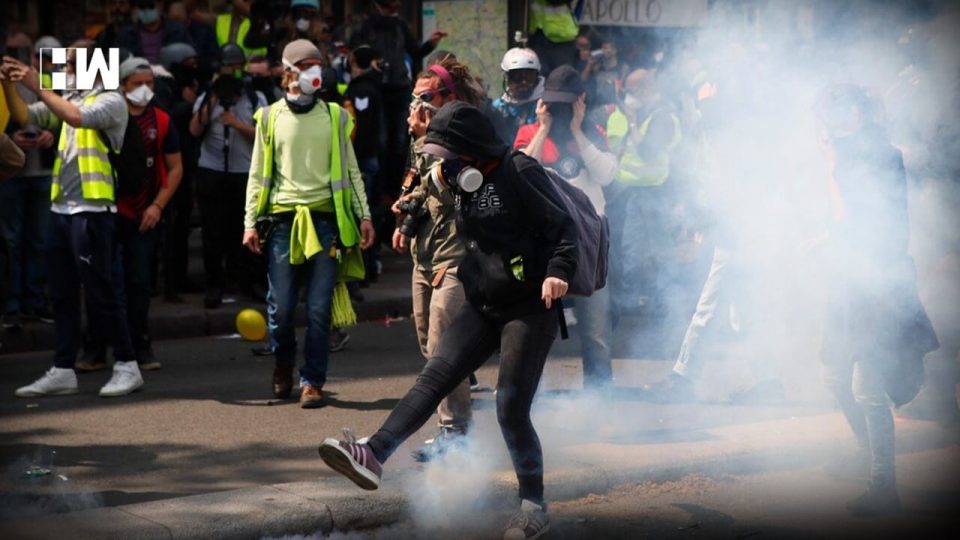Paris | Paris riot police fired teargas as they squared off against hardline demonstrators among tens of thousands of May Day protesters, who flooded parts of the city Wednesday in a test for France’s zero-tolerance policy on street violence.
Tensions were palpable as a mix of labour unionists, “yellow vest” demonstrators and anti-capitalists gathered in the French capital, putting security forces on high alert.
More than 7,400 police were out on the streets with orders from President Emmanuel Macron to take an “extremely firm stance” if faced with violence.
The clashes kicked off as crowds gathered on Montparnasse Boulevard, with hundreds of black-clad anarchists weaving their way to the front as thousands of unionists and yellow vests were quietly munching their lunch in the sun.
Suddenly they pounced, hurling bottles and chunks of broken paving stones at the security forces, shouting: “Everyone hates the police!”.
Clouds of teargas wafted into the air as the police hit back immediately, charging at the rioters and throwing stingball grenades and water cannons to break up the crowd in clashes that lasted over an hour.
There was also some friction between the hardline protesters and those who turned out just to celebrate workers’ day.
“I earn 1,200 euros ( 1,340) a month, I’m like you,” one trade unionist responded after being insulted by a “yellow vest” marcher.
French Interior Minister Christophe Castaner, visiting a Paris hospital where an injured riot officer was admitted, said the traditional May Day holiday for workers had been “hijacked by the violence” of some of the participants.
Dozens of demonstrators briefly burst into La Pitie-Salpetriere hospital with some trying to enter a resuscitation service before being ejected by police, hospital director Marie-Anne Ruder told France Inter radio.
But the initial violence and the sporadic clashes that followed fell short of the “apocalypse” threatened by hardliners, with the security forces heading off some of the excesses seen in recent months.
Authorities had warned this year’s marches would likely spell trouble, coming barely a week after leaders of the yellow vest anti-government movement angrily dismissed Macron’s offer of tax cuts.
Some 40,000 people turned out for the May Day rallies in Paris, an independent media count estimated, while unions gave a figure of 80,000 and the interior ministry put the number at 28,000.
Ministry figures for the whole country gave a turnout of 164,000 people, while France’s powerful CGT union gave a figure of 310,000 at events in some 250 towns and cities.
The sudden violence caught many marchers by surprise, with union members who were caught in the crossfire infuriated by what they claimed was an indiscriminate police crackdown.
Caught up in the melee was top CGT official Philippe Martinez who had been waiting at the head of the march where the clashes took place.
Forced to leave the area, he later returned, visibly agitated, with sharp words of criticism for the police whom he accused of attacking “clearly-identifiable union members”.
After the initial scuffles, a sense of relative calm returned as the main procession got under way.
But things degenerated again towards the end as the marchers reached Place d’Italie where black-clad agitators tried to knock down anti-riot barriers, prompting running battles with the police as the skies quickly filled with tear gas.
In the surrounding streets, some torched dustbins, while others pried the protective chipboard coverings from shop fronts and set them alight, sending black smoke pouring into the air.
Interior ministry figures showed 24 demonstrators were lightly injured along with 14 members of the security forces, while 380 people were detained for questioning of which 330 were in Paris.
Also injured was a woman journalist with Russian state news agency Ria Novosti, who said police had hit her face and arm with a truncheon despite the fact she was wearing a helmet and an armband clearly marking her as press.
The Russian foreign ministry described the incident as “unacceptable”, urging France to conduct a “meticulous investigation”.
Since November, the city has struggled to cope with the weekly yellow vest protests, which have often descended into chaos with a violent minority smashing up and torching shops, restaurants and newspaper stands.
France’s powerful labour unions had hoped to use the traditional May Day march for workers’ rights to raise their profile after finding themselves sidelined for months by the grass-roots yellow vest movement.
Elsewhere, Turkish police arrested 127 people as they sought to hold a May Day rally in an Istanbul square in defiance of a ban, while in Saint Petersburg, police detained more than 60 people after they chanted slogans against President Vladimir Putin.
And in Manila, some 8,000 protesters torched a giant effigy of Philippines President Rodrigo Duterte over his policies’ impact on the nation’s poor.
But all eyes were on Venezuela, where opposition leader Juan Guaido has called for huge May Day protests to up pressure on President Nicolas Maduro after calling on the military to rise up against him.
As the crisis deepened, Washington said it was ready to intervene militarily “if that’s what’s required”.
As an independent media platform, we do not take advertisements from governments and corporate houses. It is you, our readers, who have supported us on our journey to do honest and unbiased journalism. Please contribute, so that we can continue to do the same in future.

